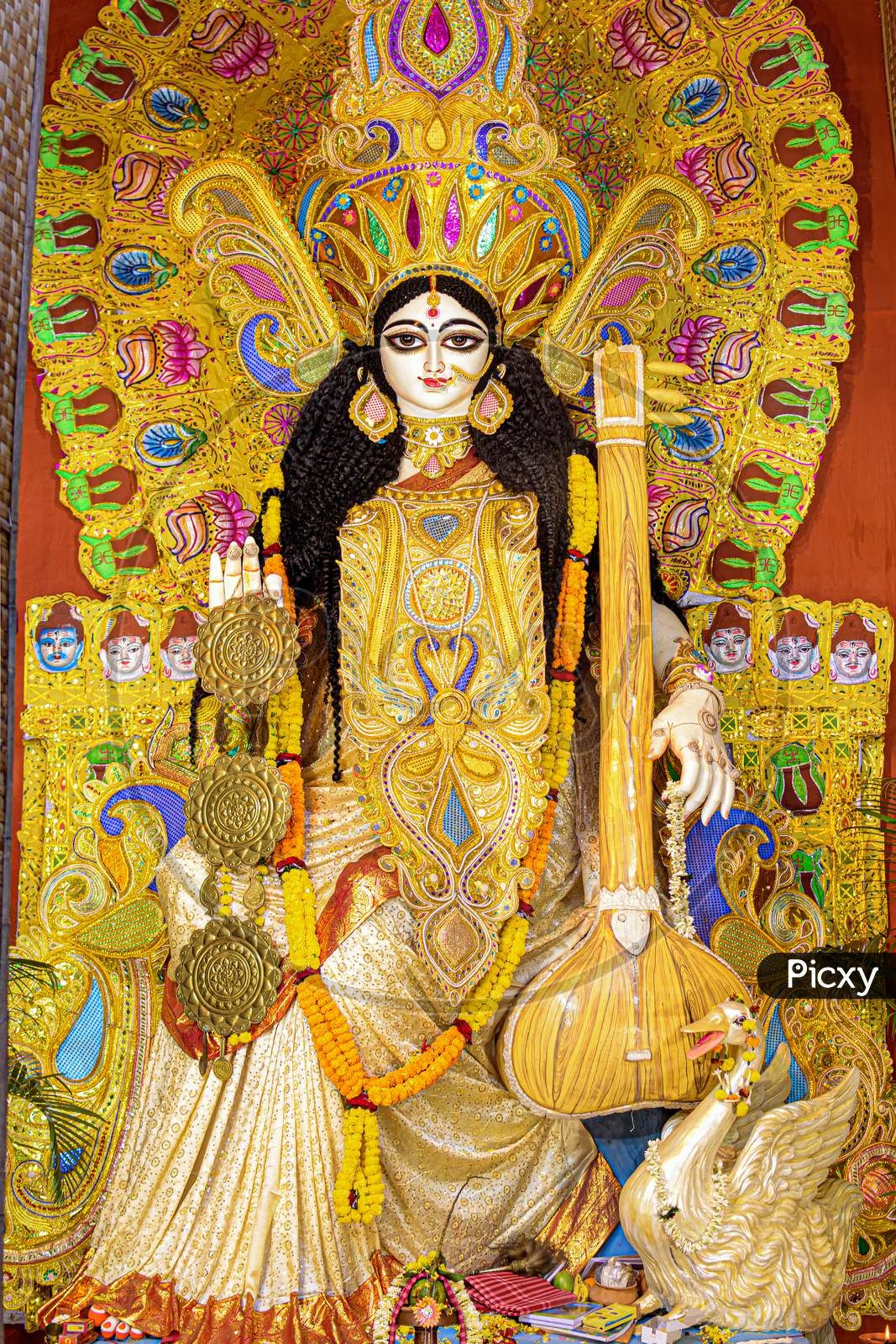Worship of the divine Goddess of learning Saraswati begins with Saraswati avahan, which invokes the Goddess when the primary star or moola nakshatra is on accent and the puja concludes on Vijayadasami. This beautiful Goddess of music and learning is clad in a white saree and flaunts Vedas, veena, and crystal rosary in her hands. She is believed to reside in the celestial sphere of Brahmaputra along with Brahma. She is the embodiment of the highest form of learning and wears a crescent on her forehead. As Saraswati is the Goddess of learning, it is a popular festival among students in various parts of India, namely the states of Orissa, West Bengal, and Bihar. Schools and colleges remain closed on the day of puja and it is celebrated on the fifth day in the month of Maagh (January-February). The worship takes place on Vasant Panchami when the paddy field is in full bloom; hence, it is also considered a harvest festival. Students gladly stay away from their books on this day and a learned priest performs the rituals of the puja. Some variations of the idol of Goddess Saraswati are also worshipped. She is depicted with eight hands, five faces and represents additional powers. The additional objects held by her are pasha or noose, chakra or disc, trishula or trident, shankha or conch, padma or lotus or ankusha or goad. She is either seen riding a peacock or swan. Peacock represents beauty, whereas the swan presents wisdom. The idol of Saraswati is placed in the hall and is beautifully decorated with flowers, such as rose, Palash, and marigolds. One important ritual observed during the worshipping of Goddess Saraswati is breaking a coconut in front of the idol. “Kool” or berry is a significant fruit of the festival. Along with berries cream, curd rice, Kheer (rice pudding), parched rice, milk, gingerly balls, parched paddy, roli, apan, clarified butter, curd, ghee and candies of sugarcane sugar are offered to the deity. After the worship of the Goddess concludes the cut fruits or “prashad” are distributed by the students, guests and teachers. Cultural programs are also held in schools and colleges after the worshipping of the deity is over. The day is celebrated with a lot of verve and excitement. A grand feast is arranged by students and the immersion of the idol takes place the following day. With a lot of fanfaronades and pomping the idol, I the Goddess is carried to a nearby lake or river by the students for the purpose of immersion. There is an educative value to the Saraswati Puja festival. Students learn how to be spiritual and respectful. They know qualities like leadership, team building, and cooperation. It instills the feeling of brotherhood and teaches the students to interact with each other peacefully and strengthen the bond of friendship.Playing the veena signifies the tuning of the intellect with the mind and knowledge so that the devotee can blend harmoniously with the universe. The prayer beads signify spiritual knowledge and bring across the message that spiritual knowledge is more powerful than secular knowledge contained in books. The deity sits on an inverted lotus that symbolizes knowledge Students pile up their books in front of the deity earnestly seeking her blessings. On this auspicious occasion of Saraswati Puja, students are allowed to study. Young girls on this day wear mustard or Basanti-coloured saree after taking a refreshing bath early in the morning. The worship of the Goddess takes place in the morning and rangoli art is made with powdered rice and flowers in from the deity. Apart from the leaves of tulsi, barley shaves, and mango blossoms offered to the deity, Palash is a vital flower used for this festival. Kool or berry is a distinctive fruit used in this puja. “Prashad” or cut fruits are distributed to the devotees and their family members after worshipping the deity. With the immersion of the statue of the Goddess of wisdom in the following evening, the Saraswati Puja comes to an end. Saraswati Puja is celebrated across the globe by Hindus. This festival is also known by the name of the Sripanchami festival and is observed on the fifth day of the spring festival on a full moon day in the month of Magh (January-February). The word Panchami means five. The Saraswati Puja festival is related to the Kaumudi Utsav and the Basant Utsav. Saraswati Puja marks the beginning of the Vasant Utsav and is celebrated for a period of fifteen days by the people of Uttar Pradesh till Dolepurnima or full moon day
The Hindu goddess of knowledge, music, art, speech, wisdom, and learning.
Jesica Sen
||
Post On > Feb 1 2023 ||






